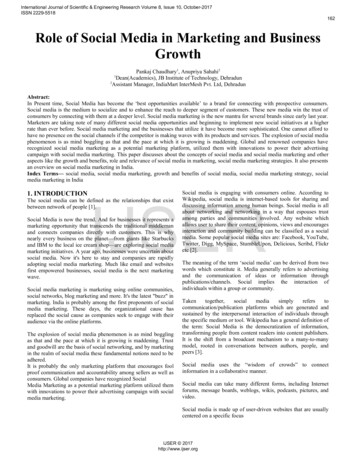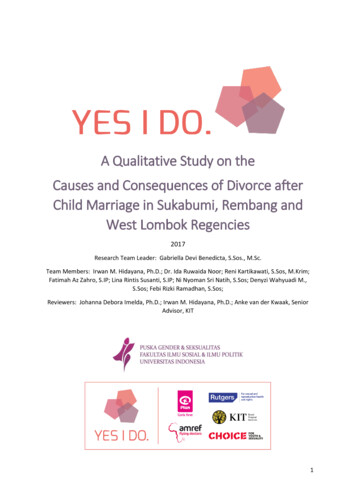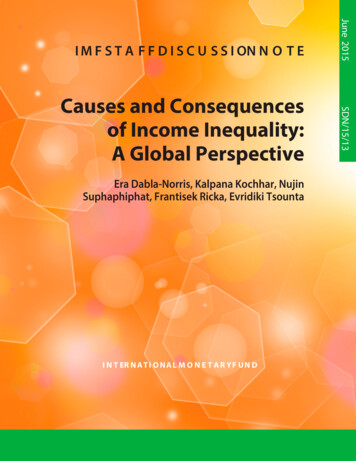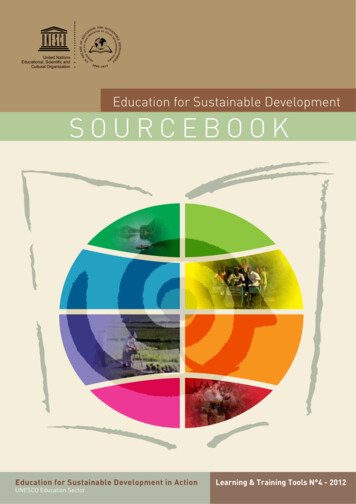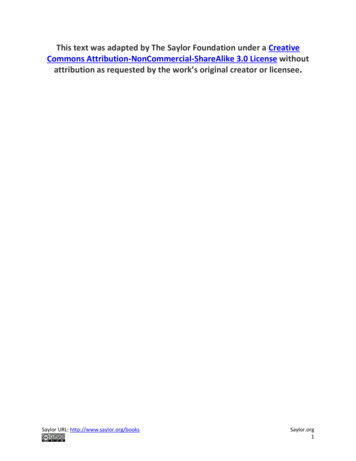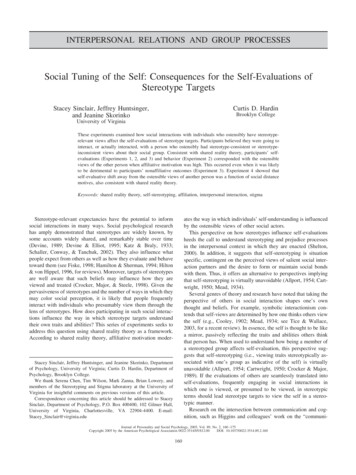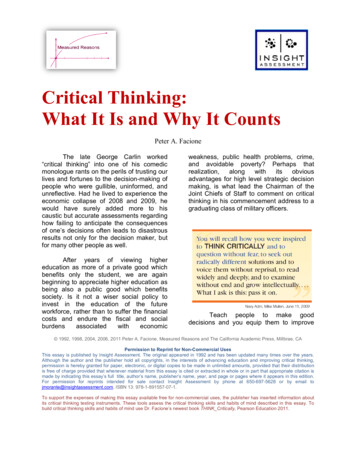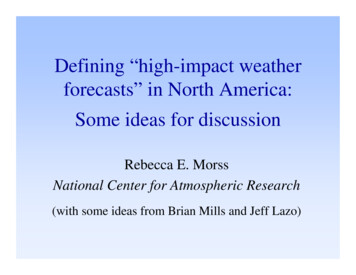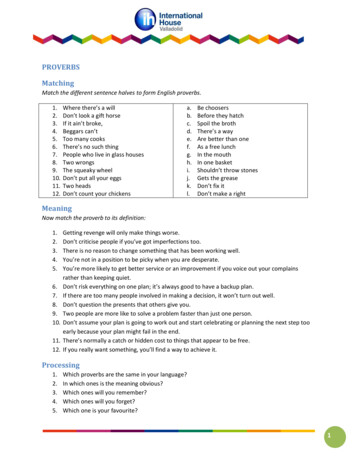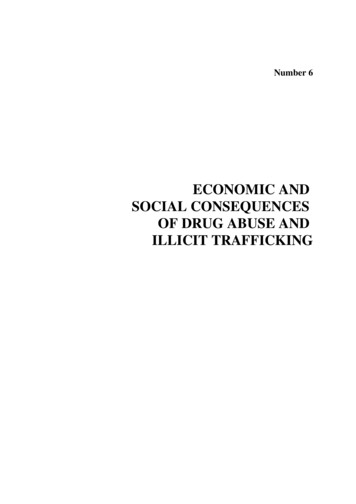
Transcription
Number 6ECONOMIC ANDSOCIAL CONSEQUENCESOF DRUG ABUSE ANDILLICIT TRAFFICKING
NOTEReferences to dollars ( ) are to United States dollars, unless otherwise stated.This publication has not been formally edited.
ContentsIntroduction . . . . . . . . . . . . . . . . . . . . . . . . . . . . . . . . . . . . . . . . . . . . . . . . . . . . . . . . . . . . 1I.Extent of the illicit drug problem . . . . . . . . . . . . . . . . . . . . . . . . . . . . . . . . . . . . . . . . .A. Production . . . . . . . . . . . . . . . . . . . . . . . . . . . . . . . . . . . . . . . . . . . . . . . . . . .B. Distribution and illicit trafficking . . . . . . . . . . . . . . . . . . . . . . . . . . . . . . . . . . .C. Consumption . . . . . . . . . . . . . . . . . . . . . . . . . . . . . . . . . . . . . . . . . . . . . . . . . .3467II. Economic consequences of drug abuse and trafficking . . . . . . . . . . . . . . . . . . . . . . . . .A. Apparent "benefits" and costs of drug abuse and trafficking . . . . . . . . . . . . . .1. “Benefits” . . . . . . . . . . . . . . . . . . . . . . . . . . . . . . . . . . . . . . . . . . . . . . . .2. Costs . . . . . . . . . . . . . . . . . . . . . . . . . . . . . . . . . . . . . . . . . . . . . . . . . . .B. Work, employment and productivity . . . . . . . . . . . . . . . . . . . . . . . . . . . . . . .1. Influence of drugs on employment status and productivity . . . . . . . . . . .2. Generation of employment . . . . . . . . . . . . . . . . . . . . . . . . . . . . . . . . . . .C. Prices and income . . . . . . . . . . . . . . . . . . . . . . . . . . . . . . . . . . . . . . . . . . . . .1. Determinants . . . . . . . . . . . . . . . . . . . . . . . . . . . . . . . . . . . . . . . . . . . . .2. Price elasticity . . . . . . . . . . . . . . . . . . . . . . . . . . . . . . . . . . . . . . . . . . . .3. Inflation . . . . . . . . . . . . . . . . . . . . . . . . . . . . . . . . . . . . . . . . . . . . . . . . .4. Income distribution . . . . . . . . . . . . . . . . . . . . . . . . . . . . . . . . . . . . . . . . .D. Trade and balance of payments . . . . . . . . . . . . . . . . . . . . . . . . . . . . . . . . . . .E. Finance and investment . . . . . . . . . . . . . . . . . . . . . . . . . . . . . . . . . . . . . . . . .1. Funds for laundering . . . . . . . . . . . . . . . . . . . . . . . . . . . . . . . . . . . . . . . .2. Savings . . . . . . . . . . . . . . . . . . . . . . . . . . . . . . . . . . . . . . . . . . . . . . . . . .3. Investment . . . . . . . . . . . . . . . . . . . . . . . . . . . . . . . . . . . . . . . . . . . . . . .4. Macroeconomic management . . . . . . . . . . . . . . . . . . . . . . . . . . . . . . . . .121212151616192020232525252727272729III. Social consequences of drug abuse and trafficking . . . . . . . . . . . . . . . . . . . . . . . . . . .A. Family and community . . . . . . . . . . . . . . . . . . . . . . . . . . . . . . . . . . . . . . . . .B. Health . . . . . . . . . . . . . . . . . . . . . . . . . . . . . . . . . . . . . . . . . . . . . . . . . . . . . .C. Education . . . . . . . . . . . . . . . . . . . . . . . . . . . . . . . . . . . . . . . . . . . . . . . . . . .D. Environment . . . . . . . . . . . . . . . . . . . . . . . . . . . . . . . . . . . . . . . . . . . . . . . . .E. Crime, corruption and dangers for civil society . . . . . . . . . . . . . . . . . . . . . . .303031353637IV. Conclusions . . . . . . . . . . . . . . . . . . . . . . . . . . . . . . . . . . . . . . . . . . . . . . . . . . . . . . . . 40Notes . . . . . . . . . . . . . . . . . . . . . . . . . . . . . . . . . . . . . . . . . . . . . . . . . . . . . . . . . . . . . . . . 42iii
AnnexesI.II.III.UNDCP Estimates of Global Turnover of the Illicit Drug Industry (1995) . . . . . . . 51Illicit drug production . . . . . . . . . . . . . . . . . . . . . . . . . . . . . . . . . . . . . . . . . . . . . . 56Substance-abuse-related mortality . . . . . . . . . . . . . . . . . . . . . . . . . . . . . . . . . . . . . 57Table1.Toxic effects and addiction risk of major illicit and licit psychoactivesubstances . . . . . . . . . . . . . . . . . . . . . . . . . . . . . . . . . . . . . . . . . . . . . . . . . . . . . . . I.XIV.XV.XVI.XVII.World illicit drug trade . . . . . . . . . . . . . . . . . . . . . . . . . . . . . . . . . . . . . . . . . . . . . . . 3Turnover of illicit drug trade compared to international trade (exports) inmajor commodities and services (1995) . . . . . . . . . . . . . . . . . . . . . . . . . . . . . . . . . . 4Trends in global production of opium poppy and coca leaf . . . . . . . . . . . . . . . . . . . . 5Seizures in 1995 . . . . . . . . . . . . . . . . . . . . . . . . . . . . . . . . . . . . . . . . . . . . . . . . . . . . 7Estimates of prevalence of illicit drug use . . . . . . . . . . . . . . . . . . . . . . . . . . . . . . . . . 9Prevalence of illicit drug abuse in the United States . . . . . . . . . . . . . . . . . . . . . . . . 10Distribution of “value added” of heroin in producer country in the GoldenCrescent . . . . . . . . . . . . . . . . . . . . . . . . . . . . . . . . . . . . . . . . . . . . . . . . . . . . . . . . . 12Generation of "value added"of heroin in distribution network from GoldenCrescent towards western Europe in the 1990s . . . . . . . . . . . . . . . . . . . . . . . . . . . 13Apparent "benefits"of illicit drug industry . . . . . . . . . . . . . . . . . . . . . . . . . . . . . . . . 14Illicit drug industry as "employer" . . . . . . . . . . . . . . . . . . . . . . . . . . . . . . . . . . . . . 19Average street purities and retail prices per gram (at street purity) in westernEurope and the United States in 1995 . . . . . . . . . . . . . . . . . . . . . . . . . . . . . . . . . . . 21Development of real (inflation-adjusted) cocaine and heroin prices in theUnited States . . . . . . . . . . . . . . . . . . . . . . . . . . . . . . . . . . . . . . . . . . . . . . . . . . . . . 21Real heroin prices in western Europe: average prices per gram in westernEurope in constant 1995 United States dollars (inflation-adjusted) . . . . . . . . . . . . . 22Real cocaine prices in western Europe: average prices per gram in westernEurope in constant 1995 United States dollars (inflation-adjusted) . . . . . . . . . . . . . 22Global development of substance-abuse-related mortality . . . . . . . . . . . . . . . . . . . . 34Substance-abuse-related mortality, United States - western Europe (1985-1995) . . 34Proportion of injecting drug abusers in HIV/AIDS population, selectedcountries in the early 1990s . . . . . . . . . . . . . . . . . . . . . . . . . . . . . . . . . . . . . . . . . . 35iv
IntroductionThe illicit drug problem can be divided into three categories: first, those illicit drugs that areeither produced or processed from natural plant products such as opium poppy: opium, morphineand heroin; secondly, synthetically produced illicit drugs, such as amphetamine; and thirdly,psychoactive pharmaceutical drugs that become illicit as a result of being diverted from licit usesor purposes. The present study is concerned primarily with the first and, to a lesser extent, thesecond category. The third category is not considered here, not because knowledge about it isscant, but because its economic and social impact is quite different from the other two categories.1An earlier version of the present study was prepared for the Commission on Narcotic Drugsat its thirty-eighth session in 1995.2 That report represented the culmination of a process thatbegan in 1990, when an Intergovernmental Expert Group met at Vienna and drew up theframework of a study dealing with illicit markets and the production, distribution and consumptionof illicit drugs. The Expert Group adopted a set of recommendations that were presented to theGeneral Assembly at its forty-fifth session in 1991. In 1993, the Assembly, in its resolution48/112, recommended that the Commission should consider including the issue of the economicand social consequences of drug abuse and illicit trafficking as an item on its agenda. At its thirtyeighth session in 1995, the Commission was presented with an earlier version (E/CN.7/1995/3)of the present report, which had been prepared by the United Nations International Drug ControlProgramme (UNDCP).After the submission of the earlier version of this study to the Commission on NarcoticDrugs, it was clear that the issues it covered were of relevance to a broader cross-section of theinternational community. Indeed, UNDCP has during the intervening period prepared variouspapers on related topics, including several reports submitted to the World Summit on SocialDevelopment held at Copenhagen.3 It was on the basis of continued interest in the economic andsocial consequences of the illicit drug problem that the present report has been revised andpublished under the UNDCP Technical Series.Assessing the economic and social consequences of illicit drug abuse and trafficking,however, implies first, that some measure of the magnitude of the problem is available andsecondly, that there is some conceptual clarity about the nature of the consequences of theseactivities. As knowledge stands, neither of those requirements is fulfilled. Estimates of the extentof illicit drug production, distribution and consumption vary enormously, and are often contingentupon the methodology and political orientation of the observer. Work on setting internationalcomparative standards for measuring the economic and social consequences of drug abuse is onlyjust beginning4 and, given the complex nature of the problem, will evolve slowly.The sources of the present study are thus as varied as its subject matter. The need to expandthe information base for such conceptual initiatives is clear, for there can be analytical drawbacksin relying solely on official figures. When official statistics do not fully or accurately reflect drug1
related trends, there is a case for cautious use of unofficial data as long as any and all unofficialsources are clearly recognized and documented as such from the outset. Official sources can, insome cases, be out of date or focus more on the symptoms or effects of drug abuse and traffickingrather than the underlying causes. Furthermore, in most cases, official statistics focus mainly oncountry-level situations and the cross-national dimension is not always discernible. The presentstudy therefore uses unofficial data where appropriate, but clearly cites and documents their use.2
I.Extent of the illicit drug problemThe order of magnitude of the extent of the illicit drug problem should be established in thelight of at least two of the unique characteristics of illicit drugs: first, they are all addictivesubstances, a fact that sometimes blurs the dividing line both between use and abuse and betweenconsumption and addiction; and secondly, though commodities that are traded or trafficked, theyare distinguished by low volume but enormously high unit cost and value. One indicator of themagnitude of the problem from an economic perspective are the estimates of the turnover of theglobal illicit drug industry. Due to the clandestine nature of the industry, its complexity andgreatly differing assumptions on its operations, estimates of the turnover of the illicit drug industryvary considerably, from about US 100 billion to more than US 1,000 billion a year. The mostfrequently found figures in the literature range from 300 billion to 500 billion a year and seemto be the most reasonable estimates. One UNDCP estimate for 1995 (see Annex I) reflectingglobal illicit drug sales to consumers, gives a figure close to 400 billion. A similar turnover wasalso estimated by the International Criminal Police Organization/ Interpol.5 Such a turnover ofthe illicit drug industry would be equivalent to approximately 8 per cent of total international trade(see Figure I). It would be larger than the international trade in iron and steel and motor vehicles(2.8 per cent and 5.3 per cent respectively) and approximately the same size as the internationaltrade in textiles (7.5 per cent), oil and gas (8.6 per cent) and world tourism (see Figure II).6 Theestimate is significantly larger than the global turnover of all pharmaceutical companies (assessedat 233 billion in 1993)7 and approximately six times larger than the amount spent on officialdevelopment assistance ( 69 billion in 1995).Figure I. World illicit drug trade(Comparative international aggregates)Sources:UNDCP, IMF, Organization for Economic Cooperation and Development.3
Figure II. Turnover of illicit drug trade compared to international trade (exports)in major commodities and services (1995)Sources:UNDCP, IMF, UNCTAD, World Tourism Organization.A. ProductionThere are no universally accepted figures on illicit drug production. Different methodologies,assumptions and political interests lead to very different estimates. The principal trends andmagnitudes are nevertheless clear. Illicit drug production, on the global aggregate, is expanding(see Figure III). That general assessment subsumes different trends in individual illicit crops.Thus, global coca and cannabis production, after having risen dramatically in the 1980s, appearsto be stagnating or falling in the 1990s; global opium production, by contrast, is still rising. Thetrends from 1985 to 1996 are shown in Annex II.Illicit crop cultivation is concentrated in certain areas, but frequently shifts within andsometimes between subregions and sometimes appears in areas where it was not previously givenofficial cognizance. Most of the world's illicit opiates come from the countries of the GoldenCrescent (Afghanistan, Iran (Islamic Republic of) and Pakistan), the Golden Triangle (LaoPeople's Democratic Republic, Myanmar and Thailand), Lebanon and Mexico. Shiftingproduction, however, makes countries such as Colombia or the central Asian republics of theCommonwealth of Independent States into fairly recent and potentially major producers ofopiates. Coca production, by contrast, is more concentrated and three Andean countries (Bolivia,Colombia and Peru) account for more than 98 per cent of world cocaine supplies. Cannabis isproduced in most parts of the world, but new areas such as the central Asian republics of theCommonwealth of Independent States, where previous production was undetermined, now showa potential to become major producers.4
The overwhelming majority of illicit drugs currently consumed are still plant products, orplant products that have undergone some semi-synthetic processes. According to a studyinvestigating consumption patterns of drug consumers in the United States of America in the early1990s, the share of illicit drugs other than cocaine, heroin and marijuana, measured in terms ofmoney spent (money is still the only common denominator available for such comparisons)8 was4 per cent over the 1990-1993 period.9 In other words, in the early 1990s more than 95 per centof the illicit drug market in the United States was constituted by traditional plant-based products.Figure III. Trends in global production of opium poppy and coca leaf(Index: 1985 100)Sources:United States Department of State, International Narcotics Control Strategy Reports,1980-1996.Synthetic drug markets are, however, developing rapidly. So far, the abundant global supplyof natural, plant-based illicit drugs is likely to have acted as one deterrent on what wouldotherwise be an accelerated shift towards synthetic drugs. The principal synthetic drugsmanufactured clandestinely are the amphetamine-type stimulants (ATS). The most widely usedATS are methamphetamine and amphetamine; a number of other amphetamine-type stimulantshave recently become popular, in particular methylenedioxymethamphetamine (MDMA), knownas "ecstasy", and methcathinone.Moreover, hallucinogens such as lysergic aciddiethylamide (LSD) are once again growing in importance. With retail prices of synthetic drugsin developed countries rather low compared with the unit price of illicit plant-based drugs, andwith the rapid spread of consumption of synthetic drugs among various sections of society, theactual importance of synthetic drugs is already much greater than the above-mentioned marketshare in illicit drug turnover suggests (compare consumption data in Figure VI). The share of allsynthetic drugs in global seizure cases, as reported to UNDCP, rose from 6.6 per cent in 1988/89to 16.3 per cent in 1994/95. The share of ATS increased over the same period from 4.4 per centto 12.4 per cent of all seizure cases, suggesting that such stimulants are one of the most"dynamic" groups of illicit drugs in terms of growth within the category of psychotropic5
substances. Slightly more than a third of all illicit laboratories detected over the 1991-1994 periodmanufactured ATS.10B. Distribution and illicit traffickingIllicit drug trafficking is the crucial link in the chain between production and consumption.It is also far and away the most lucrative stage in the process from the cultivation and processingof the illicit drug to the point of final consumption. Along the many routes on which illicit drugtraffic moves, there appears to be some spillage, partly because of a tendency of traffickers to paymiddlemen in kind. Several transit countries along trafficking routes are consequently showingevidence of increasing drug abuse and consumption.Some of the evidence for this is drawn together in a nine-country study carried out by theUnited Nations Research Institute for Social Development (UNRISD) and the United NationsUniversity (UNU): in the comprehensive survey published at the outset of the project,11 thecountry studies themselves and the overview of their findings. Several divergent patterns of illicitdrug distribution are found, depending upon: the level of activity (whether traffickers arewholesalers, middlemen or retailers); the degree of organization (whether traffickers have payrollsor enforceable "personnel policies", develop specialized departments, have vertical integration,build or fight over regional or countrywide market shares); the type of drug marketed (cannabis,cocaine, heroin or designer drugs); the existence of trafficker-insurgent-terrorist alliances; and theway organized traffickers compete for market shares.12 Individuals do not appear to be majorplayers, and early analogies to a cottage industry now make little sense for the illicit drug trade.The trade has become increasingly organized, particularly at the production, wholesale andmiddleman levels, pronouncedly so for cocaine and heroin, less so for marijuana. It tends to becontrolled by organized groups and in some cases cartels, often organized along ethnic lines tocreate stronger cohesiveness.13Cocaine trafficking begins in the Andean region and spreads northward, with North Americaand Europe as the principal final destinations. The 100 tonnes of cocaine seized in the UnitedStates in 1995 alone would have had a street value of between 2 billion (valued at minimumprices) and 20 billion (valued at maximum prices). The value of cocaine seized in the UnitedStates was thus, on average, approximatively 10 billion, larger than the individual grossdomestic product (GDP) of more than half the countries of the world. In 1995, 22 tonnes ofcocaine were seized in 35 countries in Europe (see Figure IV).14 The distribution route leads fromthe Andean countries through Central America, Mexico and the Caribbean region, althoughalternative routes through South America (Argentina, Brazil), Africa and Europe (partly easternEurope) have also become popular. Nevertheless, from 50 to 70 per cent of total United Statescocaine imports transit Mexico which, in confirmation of the spillage phenomenon noted above,is beginning to show signs of increasing cocaine consumption.15In 1995, 9 tonnes of heroin were seized in Europe (35 countries), compared with 1.1 tonnesin the United States (see Figure IV).16 The majority of heroin consumed in Europe originates inSouth-West Asia, which provided from 70 to 90 per cent of European heroin seized over the1993-1995 period.17 Heroin trafficked to North America, by contrast, largely originates in SouthEast Asia, which provides more than half of North American demand,18 with the rest coming from6
Colombia, Mexico and South-West Asia.19 Most heroin processing takes place close to the pointof origin. The route of distribution to North America involves countries and areas such as China,Hong Kong, Malaysia, Thailand and, increasingly, African countries for transshipment purposes.The heroin-smuggling route from South-West Asia to Europe goes mainly through Pakistan, theIslamic Republic of Iran and Turkey, and along the Balkan route (which accounts for 70 to 90 percent of all heroin seizures in Europe),20 although smuggling through the Central Asian Republicsof the Commonwealth of Independent States is becoming popular. The opening of the bordersbetween east and west in Europe facilitated contacts and communication that were also used bydrug traffickers, increasing the number of transit routes for drugs and markets for drugconsumption.21Figure IV. Seizures in 1995a/35 countries: including Turkey and Russia; 760 million peoplepeople.Sources:UNDCP, ARQ Data.b/ 260 millionAs far as is known, the trafficking of clandestinely manufactured synthetic drugs, in contrastto illicit plant-based drugs, is more of an intraregional activity, with interregional traffickinggenerally limited to precursors for the production of such drugs.22C. ConsumptionThere is little reliable information available on an international basis about the extent of illicitdrug consumption. Methodologically sound surveys of the incidence, prevalence and frequencyof illicit drug use are primarily local studies. At the national level, they are few and far betweenand, in international terms, they are at an early stage of development. This is primarily due to thefact that national systems for estimating consumption are heterogeneous, and the results aretherefore not always comparable.237
Some general assessment is nonetheless possible. Global illicit drug use increased stronglysince the 1970s, and this upward trend, though moving at a somewhat slower pace, is likely tocontinue for some time. Illicit drug consumption in the United States which, in contrast to theglobal trend, actually declined from the high levels of the 1980s, has been increasing since 1992.Eastern Europe and the countries of the Commonwealth of Independent States are notingincreased usage in the 1990s; so, also, are Africa, many parts of Asia, Latin America and westernEurope. Consumption of illicit drugs looks like becoming a global phenomenon, no longerconfined to the status of a demand problem in industrialized countries. The traditional distinctionbetween supplier and consumer countries is breaking down. The developing countries thatproduced, but tended not to consume, illicit drugs, are showing increased domestic consumption,more often of modern rather than traditional drugs: bazuco in Bolivia, Colombia and Peru; heroinin Myanmar, Pakistan and Thailand; methamphetamine in Far-East and South-East Asiancountries; fenetylline in several countries of the Arabian peninsula and methaqualone in severalcountries of southern Africa.The largest single consumer of illicit drugs in the world, however, still seems to be the UnitedStates, with some 12.8 million current drug abusers (i.e. those who have consumed drugs at leastonce in the last month) out of a total population of 260 million in 1995. Drug abusers represent6.1 percent of the population aged 12 years and over. An estimated 3.6 million people havesevere drug problems and are in need of professional drug treatment services.24 The number ofpeople having consumed illicit drugs at least once in the year prior to the survey (1994) was 25.9million or 12.4 per cent of the population aged 12 years and over. Such figures are high not onlyin absolute terms, but also in comparison with the prevalence rates reported in most other partsof the world. Only a few countries, for instance Australia and Brazil, report slightly higherprevalence rates, due mainly to more widespread consumption of cannabis.In Figure V, drug abuse in North America (United States and Canada combined) is comparedwith drug abuse in western Europe, which, in economic terms, is the second largest market forillicit drugs. The information presented in Figure V should, however, be treated with reservationas it is based on an enormously heterogeneous and fragmented set of data, and mainly intendedto establish some basic orders of magnitude. It should also be noted that differences in the levelof abuse between different countries of western Europe are sometimes greater than the differencesbetween western Europe and North America. Leaving aside the more widespread consumptionof cannabis in the United States, the data in Figure V and Figure VI show very clearly that thedrug problem in the United States is still largely one of cocaine abuse. Even rapid rises in heroinconsumption in the United States since 1992/93 have not changed this substantially. The abuseof cocaine in the United States is still much more common than in Europe, although cocaine alsoseems to have emerged in western Europe as the most widely abused illicit plant-based drug aftercannabis. In contrast to the situation in the United States, cocaine in Europe is less widely abusedthan the ATS. The abuse of ecstasy has risendramatically in Europe in the 1990s, but this is not adequately reflected in the data presented inFigure V. Finally, heroin abuse appears to be marginally higher in Europe than in the UnitedStates.8
Figure V. Estimates of prevalence of illicit drug abuse(Percentage of total population, 1992-1994)a/b/Canada, United States.Europe: Belgium, Denmark, Finland, France, Germany, Italy, Netherlands, Norway, Portugal, Spain,Sweden, Switzerland and the United Kingdom of Great Britain and Northern Ireland.Sources:UNDCP country profiles. United States Department of Health and Human Services (SubstanceAbuse and Mental Health Services Administration), Preliminary Estimates from the 1994 NationalHousehold Survey on Drug Abuse, Washington, D.C., September 1995, and annual reportsquestionnaires.Although some countries in East and South-East Asia (such as Japan, Republic of Korea, thePhilippines and Thailand), as well as a large number of countries in Latin America, report alarminglevels of ATS abuse, most illicit consumption of synthetic drugs still seems to take place indeveloped countries. In many developed countries in Europe, and in Australia and the UnitedStates, the prevalence of abuse of synthetic drugs (including hallucinogens, stimulants andsedatives diverted from licit trade) is already higher than that of heroin and cocaine combined.The example of the United States given in Figure VI shows that such is the case for annualprevalence. Within the general category of synthetic drugs, the abuse of one particular ATS,‘ecstasy’, is growing rapidly in both developed and developing countries, and is testimony to thepowerful influence of social trends on drug abuse.In addition to magnitudes of consumption, some general and very tentative assessments ofthe characteristics of abusers are possible. Illicit drug abuse is most common among men,although it is reported to be on the increase among women. In general, however, women seemto gravitate towards the abuse of legal, socially acceptable substances and prescription drugs. Theresults of many studies indicate that the abuse of licit (prescription) drugs is more common amongwomen than men.25Although illicit drug abuse is prevalent among all age groups, it is most frequent amongyoung adults. Most abusers are in the 15-35 age group, though there is a greater concentration9
within the 18-25 age group. The employed have significantly lower rates of drug abuse thanunemployed persons of the same age. Married people are less likely to abuse drugs than single,separated or divorced persons. Prison populations show a high incidence of drug abuse.In the annual reports questionnaire (ARQ)*, Governments report that drug abuse is, ingeneral, stronger in urban settings. Many (e.g. Chile, China, Ecuador, India, Mexico, Pakistanand Thailand) also report the emergence of a frontier abuse pattern. Rural drug abuse isassociated with traditional consumption (opium in Asia, coca leaves in Latin America) and olderabusers. In Asia, addiction rates correlate highly with access to opium-producing and traffickingareas; in Latin America, this is far less the case with cocaine.26Figure VI. Prevalence of illicit drug abuse in the United States(Percentage of population 12 years (1994))Sources:United States Department of Health and Human Services (Substance Abuse and Mental Health ServicesAdministration), Preliminary Estimates from the 1994 National Household Survey on Drug Abuse,Washington, D.C., September 1995.Cannabis appears to be abused by people from all social classes. In developing countries,traditional abuse of opiates seems common among the very poor. By contrast, abuse amongcollege students is related to family income.27 Opium and heroin consumption in middle to highincome countries in South-West and South-East Asia is often associated with lower incomegroups. In the least developed countries (such as Myanmar) heroin consumption seems to*In compliance with the international drug control conventions, UNDCP sends out an annual questionnaire (the ARQ)to all States-Members of the United Nations. Responses to the ARQ constitute UNDCP’s main data-set on illicit drugproduction, trafficking and abuse.10
correlate more strongly to better-educated abusers from a wealthy urban background (almost halfthe students at Rangoon University are reported to have experimented with heroin), while opiumabusers are from rural low income groups. As regard
of the illicit drug market in the United States was constituted by traditional plant-based products. Figure III. Trends in global production of opium poppy and coca leaf (Index: 1985 100) Sources: United States Department of State, International Narcotics Control Strategy Reports, 1980-1996. Synthetic drug markets are, however, developing rapidly.

